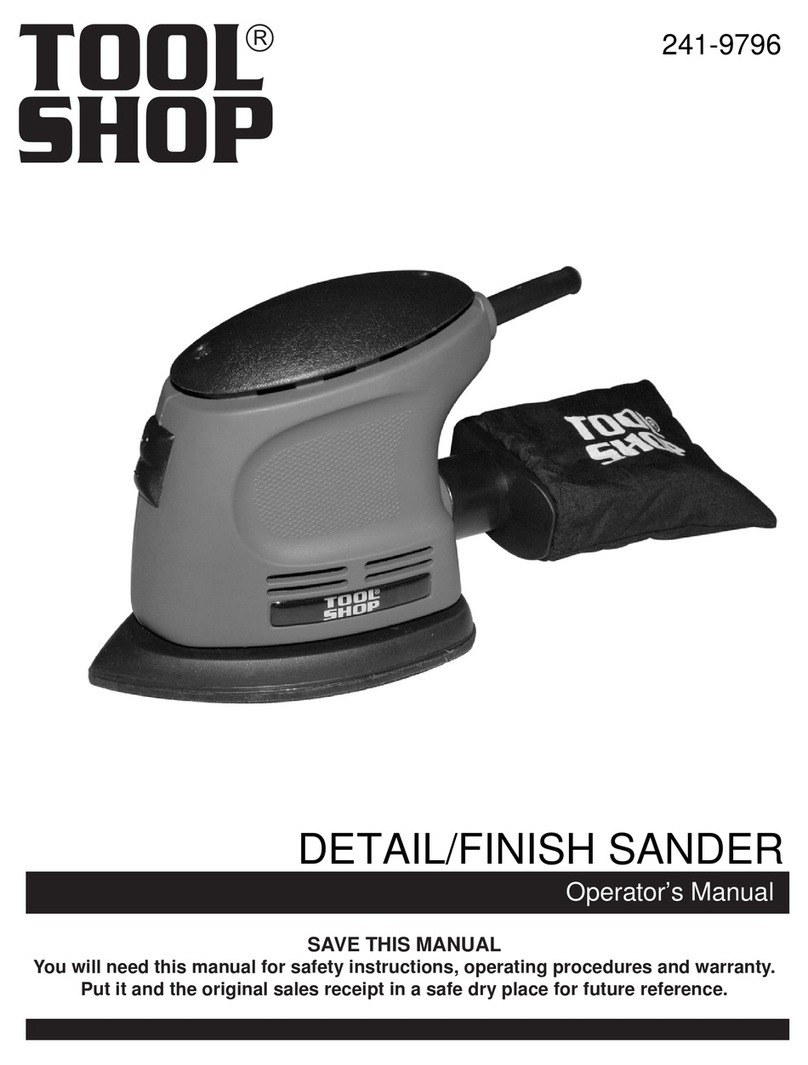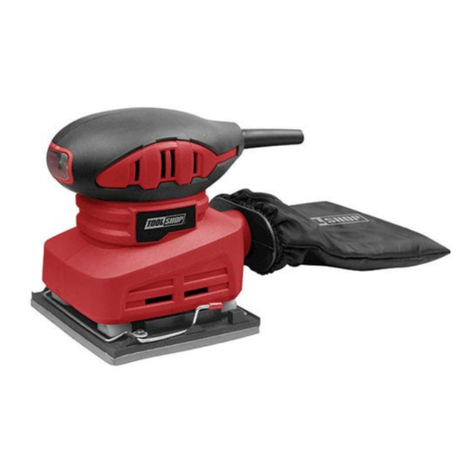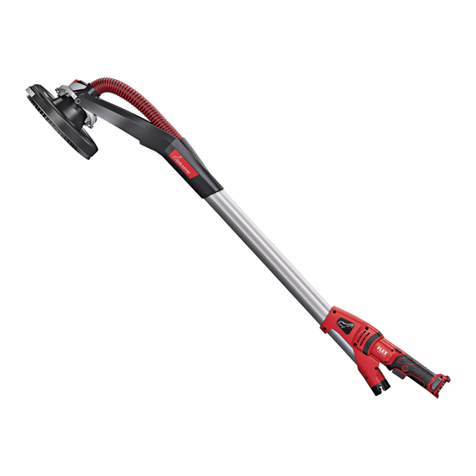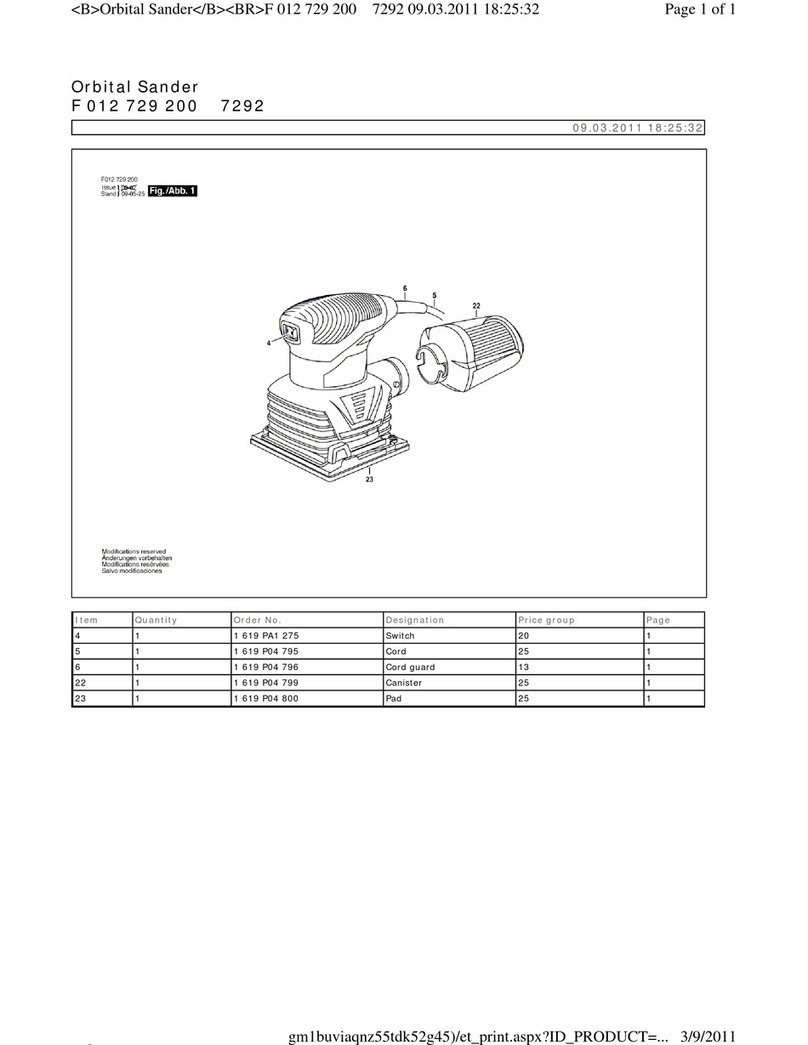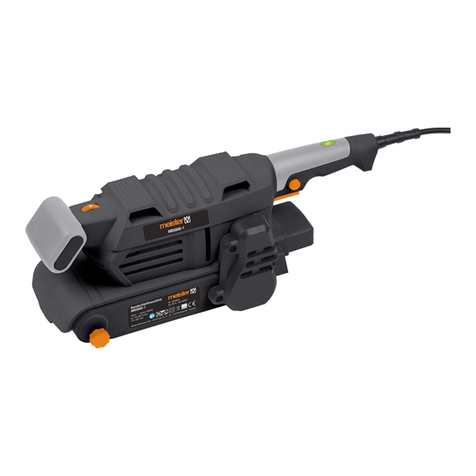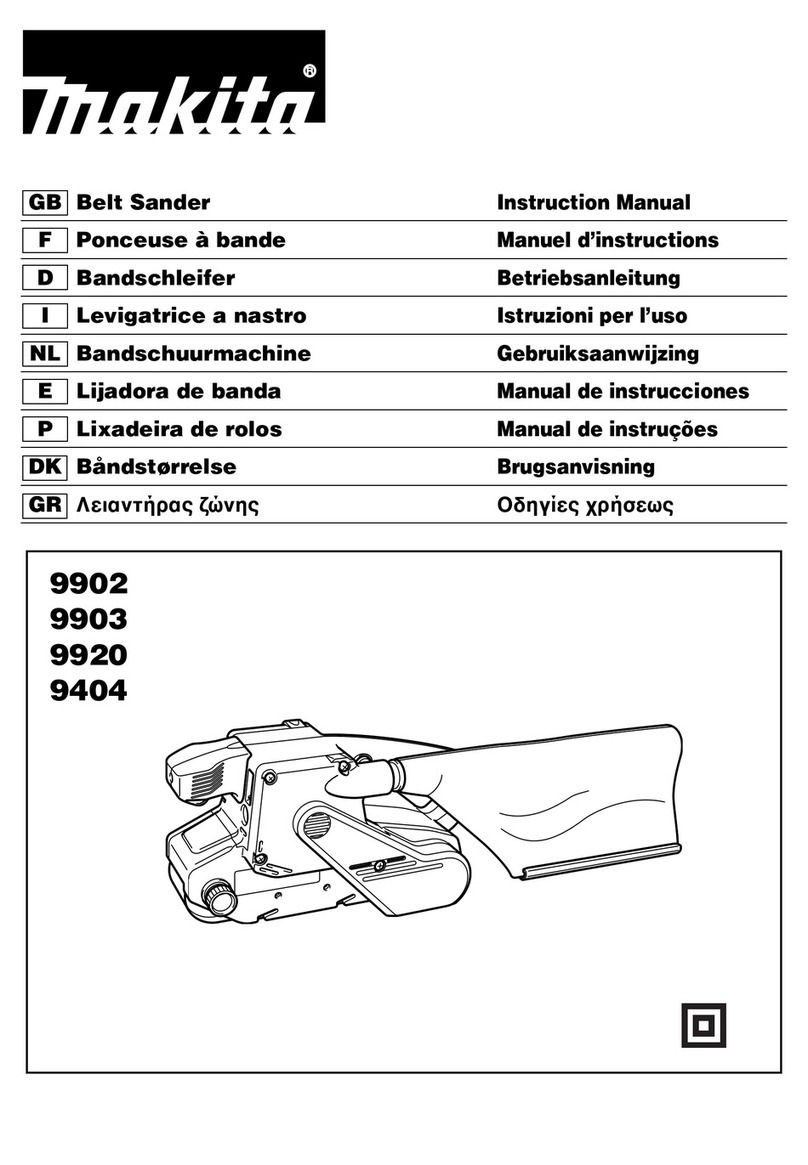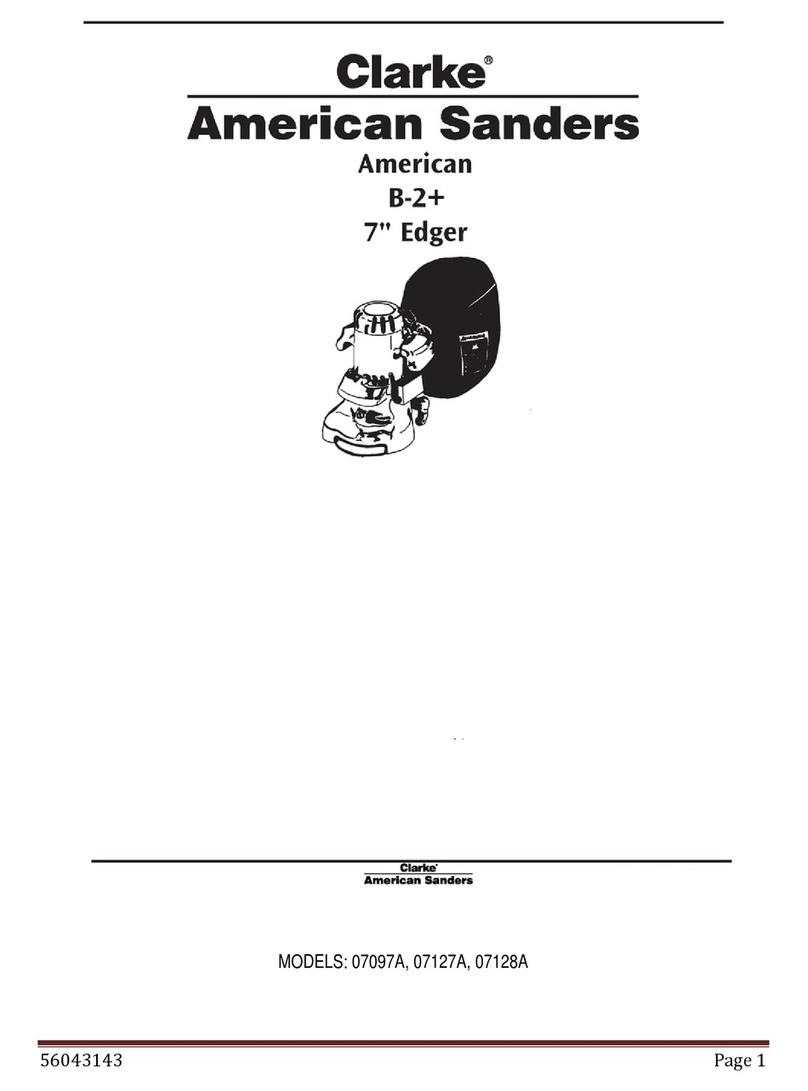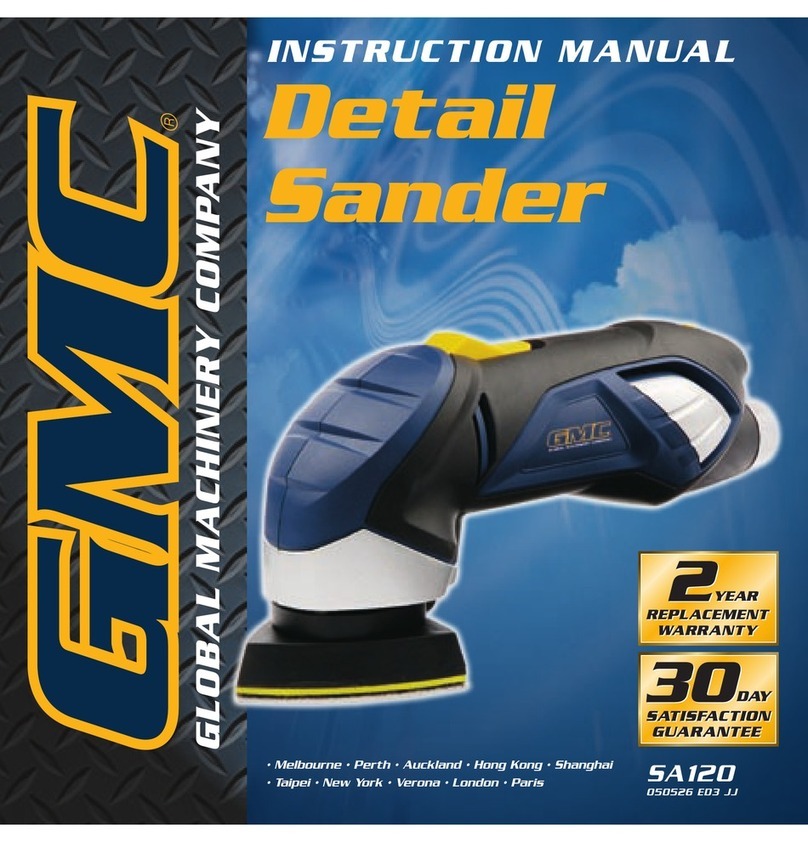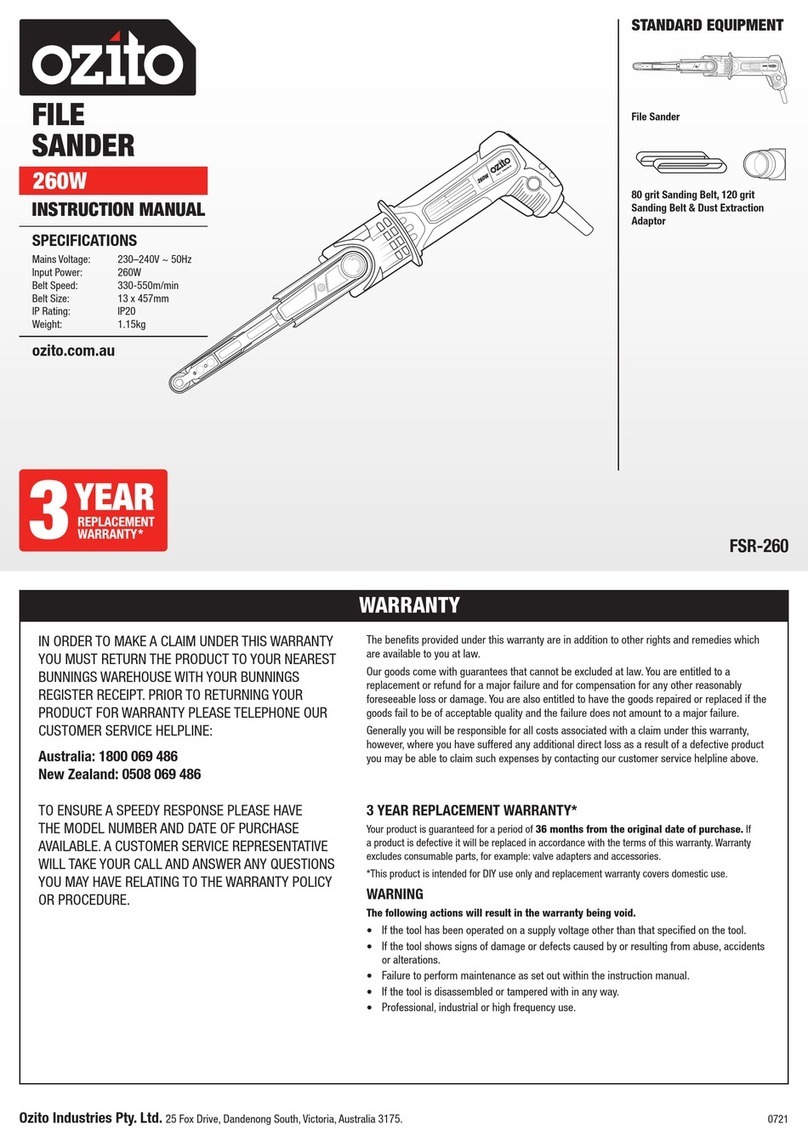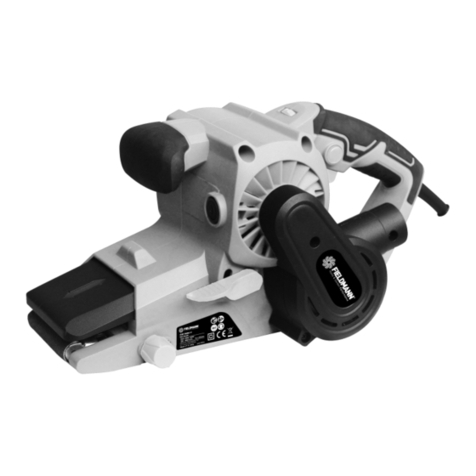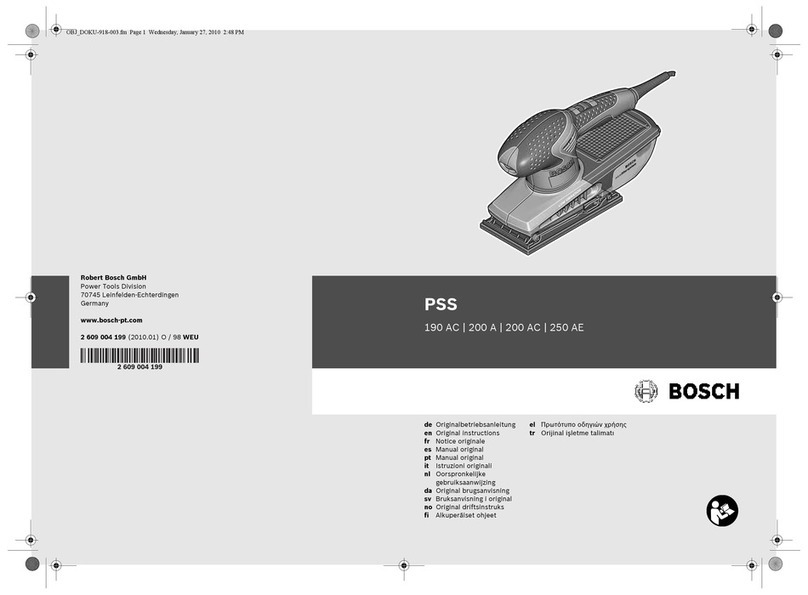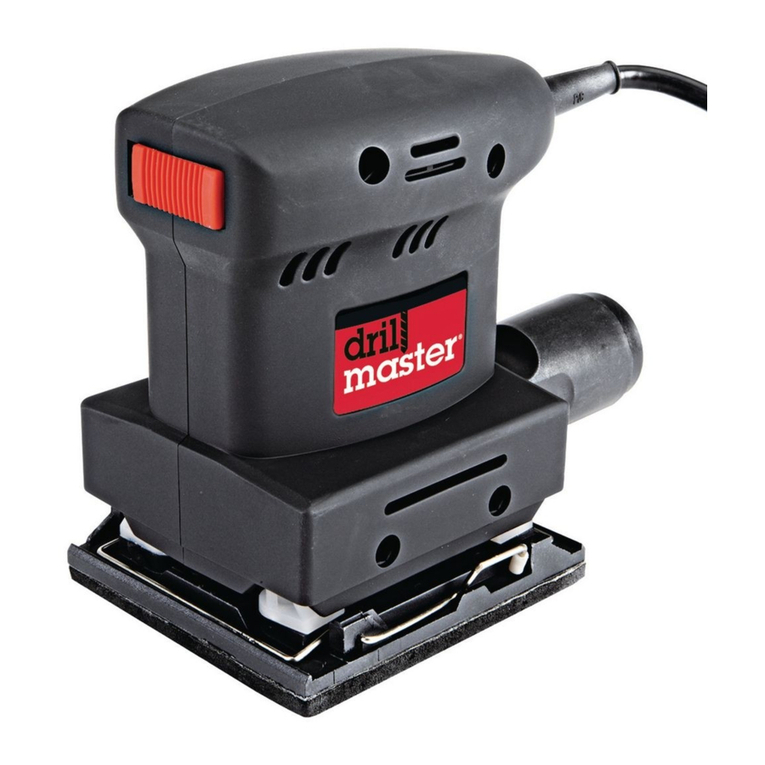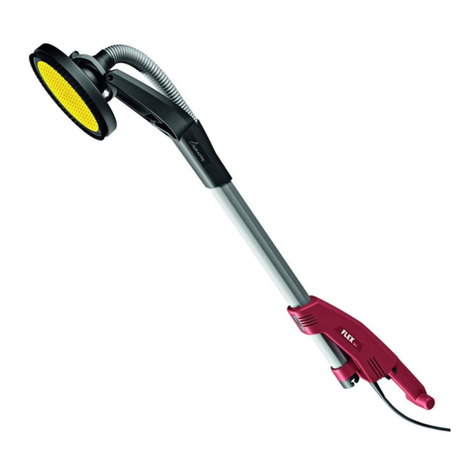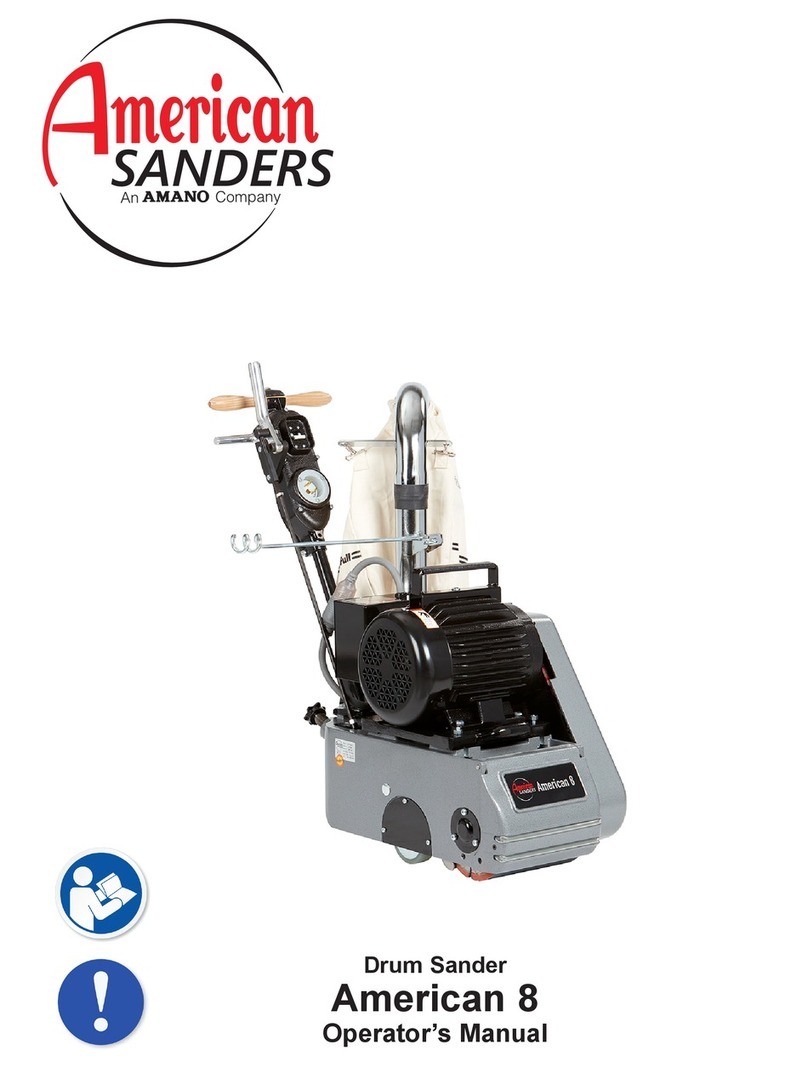Toolshop 241-9796 User manual

SAVE THIS MANUAL
You will need this manual for safety instructions, operating procedures and warranty.
Put it and the original sales receipt in a safe dry place for future reference.
Operator’s Manual
DETAIL SANDER
241-9796
For questions about this product, Please call 1-866-915-8626

2
IMPORTANT SAFETY INSTRUCTIONS
WARNING:When using electric tools, machines or equipment, basic safety
precautions should always be followed to reduce the risk of fire,
electricshock, and personal injury.
READ ALL INSTRUCTIONS BEFORE USING THIS TOOL
1. KEEP WORK AREA CLEAN. Cluttered areas can cause injuries.
2. CONSIDER WORK AREA ENVIRONMENT. Don’t use power tools in damp,
wet, or poorly lit locations. Don’t expose tools to the rain. Keep the work area
well lit. Don’t use tools in the presence of flammable gases or liquids.
3. KEEP CHILDREN AND BYSTANDERS AWAY. All children should be kept
away from the work area. Don’t let them handle machines, tools or extension
cords. Bystanders can be a distraction and can be injured.
4. GROUNDED TOOLS must be plugged into an outlet that is properly
installed and grounded. Grounding provides a low-resistance path to carry
electricity to the ground away from the operator, should the tool malfunction
electrically. Do not remove the grounding prong from the plug or alter the plug in
any way. If in doubt as to whether the outlet is properly grounded according
to code, check with a qualified electrician.
5. OBSERVE PROPER PRECAUTIONS REGARDING DOUBLE INSULATION.
This tool is double insulated. It is equipped with a polarized plug.
One blade is wider than the other, so it will fit into a polarized outlet only one
way. If you have difficulty inserting the plug, try reversing it. If it still doesn’t
fit, do not alter the plug; have a qualified electrician install a polarized outlet.
6. GUARD AGAINST ELECTRIC SHOCK. Prevent body contact with grounded
surfaces: pipes, radiators, ranges, and refrigerator enclosures. When your
body is grounded the risk of electric shock increases. When working wherever
“live” electrical wires may be encountered, try to ascertain whether there
is a danger of shock. DO NOT TOUCH ANY METAL PARTS OF THE TOOL
while using it. Hold the tool only by the plastic grip to prevent electric shock if
you contact a live wire.
7. DO NOT MISUSE THE CORD. Never carry your tools by the cord or pull on
the cord to unplug it. Protect the cord from potential sources of damage:
heat, oil & solvents, sharp edges, or moving parts. Replac e damaged cords
immediately.
8. WHEN WORKING OUTDOORS, USE AN OUTDOOR-RATED EXTENSION
CORD. An extension cord rated for outdoor use must be marked “W-A” or
“W”.
9. DO NOT EXPOSE ELECTRICAL POWER TOOLS TO MOISTURE. Rain or
wet conditions can cause water to enter the tool and lead to electric shock.
10. ENSURE THE EXTENSION CORD YOU USE IS OF SUFFICIENT GAUGE
FOR ITS LENGTH.
11. STORE IDLE EQUIPMENT. Store equipment in a dry area to inhibit rust.
Equipment also should be in a high location or locked up to keep out of
reach of children.
12. DON’T FORCE THE TOOL. It will do the job better and more safely at the
rate for which it was intended.
13. USE THE RIGHT TOOL. Don’t force a small tool or attachment to do the
work of a larger industrial tool. Don’t use a tool for a purpose for which it was
not intended.
14. DRESS PROPERLY. Don’t wear loose clothing or jewelry; they can be
caught in moving parts. Protective, non-electrically conductive gloves, protective
eyewear and non-skid footwear are recommended. Wear protective hair
covering to contain long hair and keep yourself from harm.
Recommended Minimum Wire Gauge for Extension Cords
Amps
from
Tool Nameplate
25’ length 50’ length 75’ length 100’ length 150’ length 200’ length
0-5 amps 16 ga. 16 ga. 16 ga. 14 ga. 12 ga. 12 ga.
5.1-8 amps 16 ga. 16 ga. 14 ga. 12 ga. 10 ga. Do Not Use
8.1-12 amps 14 ga. 14 ga. 12 ga. 10 ga. Do Not Use Do Not Use
12.1-15 amps 12 ga. 12 ga. 10 ga. 10 ga. Do Not Use Do Not Use
15.1-20 amps 10 ga. 10 ga. 10 ga. Do Not Use Do Not Use Do Not Use
!

SAFETY PRECAUTIONS FOR DETAIL SANDER
•
•Do not put undue pressure on the sander such that it slows down.
•After switching off, always wait until the sander has stopped before putting it
down.
•Do not expose this tool to water or liquids. The abrasive pads, steel wool pad,
and polishing pad are not intended for wet use.
IMPORTANT SAFETY INSTRUCTIONS
15. USE EYE PROTECTION. Use a full-face mask if the work you’re doing
produces metal filings, dust or wood chips. Goggles are acceptable in other
situations. Wear a clean dust mask if the work involves creating a lot of fine
or coarse dust.
16. SECURE WORK. Use clamps or a vise to hold the work, this frees both
hands to operate the tool.
17. DON’T OVERREACH. Keep proper footing and balance at all times. Do not
reach over or across machines that are running.
18. MAINTAIN TOOLS. Keep tools sharp and clean for better and safer
performance. Follow instructions for lubricating and changing accessories.
For safe performance. Keep handles dry, clean and free from oil and grease.
19. AVOID UNINTENTIONAL STARTING. Be sure the switch is in the OFF position
before plugging in.
20. ALWAYS CHECK AND MAKE SURE TO REMOVE ANY ADJUSTING KEYS
OR WRENCHES before turning the tool on. Left attached, these parts can fly
off a moving part and result in injury.
21. DO NOT USE THE TOOL IF IT CANNOT BE SWITCHED ON OR OFF.
Have your tool repaired before using it.
22. DISCONNNECT THE PLUG FROM THE POWER SOURCE BEFORE MAKING
ANY ADJUSTMENTS.
Changing attachments or accessories can be dangerous
if the tool could accidentally start.
23. STAY ALERT. Watch what you are doing & use common sense. Don’t operate
any tool when you are tired.
24. CHECK FOR DAMAGED PARTS. Before using this tool, any part that is
damaged should be carefully checked to determine that it will operate properly
and perform its intended function. Check for alignment of moving parts,
binding of moving parts, breakage of parts, mountings, and other conditions
that may affect its operation. Inspect screws and tighten any ones that are
loose. Any part that is damaged should be properly repaired or replaced by
an authorized service center unless otherwise indicated elsewhere in the in-
struction manual. Have defective switches replaced by an authorized service
center. Don’t use the tool if switch does not turn it on and off properly.
25. REPLACEMENT PARTS. When servicing, use only identical replacement
parts.
26. SERVICE AND REPAIRS should be made by qualified repair technicians at
an authorized repair center. Improperly repaired tools could cause serious
shock or injury.
!
3

4
Voltage: 120 Volts AC, 60Hz
No load speed: 12,000 OPM
Dust-sealed front rocker switch
Sanding sheet size: 3-3/4” X 5-1/2”
Includes 3 pcs. sanding paper (80,120,180)
OPERATING PROCEDURES
INSTALLING SANDPAPER
WARNING: Unplug the sander before replacing sandpaper.
The Detail Sander comes complete with a 5 hole hook and loop style mounting
system. The palm sanders sanding sheets will be affixed to the sanders
base without the use of clamps.
Connect the sanding sheet to the sanding plate:
Turn the tool upside down. Next, align the sanding sheet with the sander’s base
and press the sanding sheet firmly into place. Confirm that the holes punched in
the sanding sheet match the dust holes in the sanding plate. Holes must match for
the dust system to work properly.
To remove the sanding sheet, carefully peel the sanding sheet away from the
sanding plate.
NOTE: Check the sandpaper regularly for tears, cracking, and other damage.
Damaged paper can allow the pad beneath to be damaged.
Because of the operator vigilance required, the pad is considered a
consumable part and is not covered under warranty.
RUNNING THE TOOL
1. Identify the item you wish to sand or polish and choose the proper grit sandpa-
per or abrasive pad best suited for the job. If preparing wood for painting or
removing paint, use a course grit sanding sheet. Use a fine grit for finishing
work.
2. Secure the item to be sanded. Make sure that the sanding sheet is firmly
fixed to the sander.
3. With the sander not in contact with the workpiece, press the Switch to the “ON”
position.
4. Carefully place the palm Sander onto the workpiece and begin sanding.
WARNING: Do not sand any area to heavily or for more than a few seconds at a
time. Apply even pressure in a random pattern over the en tire surface.
SPECIFICATIONS
!
FUNCTIONAL DESCRIPTION
1
2
3
1. Dust-sealed on/off switch
2. Sanding base
3. 1-1/4" vacuum adapter
Current Rating: 0.8 Amp
!
!
!

5. To sand down profiles and grooves, use the point or edge of the sander base.
6. Every few minutes, check the condition and wear of the sanding sheet. Replace
if necessary.
5
WARNING: Do not use torn or severely worn sandpaper. You may damage your
work surface or suffer physical injury.
7. When you are done sanding the desired area, remove the sander from the
work surface before turning the sander OFF.
CONTROL THE DUST IN THE WORKPLACE.
For dust collection to work, the five dust extraction holes must be aligned properly
between the sanding sheets and sanding pad. Using the dust extraction feature of
the sander also helps prevent the sandpaper from loading quickly with sawdust.
At the back of your sande
hose.
Note: Vacuum hose is sold separately.
r, you can attach a 1-1/4" vacuum adapter with a 1-1/4” ID
SANDING
Use a grade of sandpaper that will make finer marks than those already on the
surface. Too coarse a grade will not make the surface smoother while too fine a
grade will remove scratches too slowly, or not at all. Continue using finer grades of
sandpaper until you obtain the desired finish.
When removing old paint, determine how much paint really needs to be removed.
Consider that old paint may well be toxic and will have to be treated with the
respect due any toxic material both on the part of the tool operator and environment.
Wear appropriate breathing protection and dispose carefully of dust or chips
left after sanding.
MAINTENANCE
1. Keep the vents clear of dust and debris. This will help prevent possible electri
cal shorts and ensure proper cooling.
2. Keep the tool housing clean and free of oil and grease by using mild soap and a
damp (not wet) cloth.
3. Inspect the cord regularly and have it replaced by an authorized repair facility if
it is damaged.
4. Lubrication for this tool is done at the factory and should not be necessary
again under normal use.
5. An authorized repair center should do any repairs, modification, or maintenance
that involves disassembling the tool.
6. Any damage to the tool should be corrected at an authorized repair center.
CLEANING
Use mild soap and a damp cloth to clean the sander. Do not use gas, turpentine,
lacquer, paint thinners which could damage the plastic casing. Do not allow liquids
to get inside the sander. Never immerse the sander in liquid.
OPERATING PROCEDURES
!

6
Screw Label
Sand paper Left housing
Sanding plate Rubber cover
Base support Screw
Bearing Bearing
Bushing Terminal block
Bearing Cord clamp
Fan Cord guard
Rotor Power cord
Stator Screw
Brush holder Screw
Switch cover Right housing
Switch Label
PARTS LIST
Please refer to the schematic drawing on page 7.
ITEM DESCRIPTION DESCRIPTIONITEM
1
2
3
4
5
6
7
8
9
10
11
12
13
14
15
16
17
18
19
20
21
22
23
24
25
26

7
SCHEMATIC DRAWING
!WARNING: Repairs should be made by an authorized repair center. Do not
this power tool . Contact at
for questions regarding this power tool.
1-866-915-8626
open or disassemble

8
TOOL SHOP®
1-YEAR LIMITED WARRANTY:
For questions /comments, technical assistance or repair parts –
Please call toll free at: 1-866-915-8626
(M-F8am – 5pm EST)
SAVE YOUR RECEIPTS. THIS WARRANTY IS VOID WITHOUT THEM.
DETAIL PALM SANDER WARRANTY
This TOOL SHOP
®
brand power tool carries a 1-Year Limited Warranty to the
original purchaser. If, during normal use, this TOOL SHOP
®
tool fails due to a
defect in material or workmanship within one (1) year from the date of purchase,
simply bring this tool with your original sales receipt back to your nearest
MENARDS
®
retail store. At its discretion, TOOL SHOP
®
agrees to have the tool
replaced with the same or similar TOOL SHOP
®
product free of charge, within the
stated warranty period, when returned by the original purchaser with original sales
receipt. Notwithstanding the foregoing, this limited warranty does not cover any
damage that has resulted from abuse or misuse of the Merchandise. This warranty:
(1) excludes expendable parts including but not limited to blades, belts, bits, light
bulbs, and/or batteries; (2) shall be void if this tool is used for commercial and/or
rental purposes; and (3) does not cover any losses, injuries to persons/property or
costs. This warranty does give you specific legal rights and you may have other
rights, which vary from state to state. Be careful, tools are dangerous if improperly
used or maintained. Seller's employees are not qualified to advise you on the use of
this Merchandise. Any oral representation(s) made will not be binding on seller or
its employees. The rights under this limited warranty are to the original purchaser of
the Merchandise and may not be transferred to any subsequent owner. This limited
warranty is in lieu of all warranties, expressed or implied including warranties or
merchantability and fitness for a particular purpose. Seller shall not be liable for any
special, incidental, or consequential damages. The sole exclusive remedy against
the seller will be for the replacement of any defects as provided herein, as long as
the seller is willing or able to replace this product or is willing to refund the purchase
price as provided above. For insurance purposes, seller is not allowed to demonstrate
any of these power tools for you.
Table of contents
Other Toolshop Sander manuals
